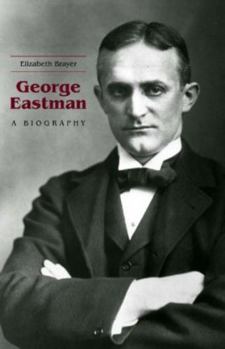George Eastman: A Biography
Select Format
Select Condition 
Book Overview
Now back in print, this life of George Eastman is the first biography since 1930 of the man who transformed the world of photography. In this revealing and informative work, Brayer shows us how such key innovations as roll film and the light, hand-held camera helped the Eastman Kodak Company dominate the world market. More importantly, Brayer draws a vivid portrait of the man behind the money. Eastman worked hard at staying out of the limelight and even insisted that his donations be kept anonymous, prompting the Boston Globe to call him "America's most modest and least-known millionaire." Despite his retirement in 1925, Eastman showed little sign of slowing down.Making money had been interesting, but putting money to work became more so. In the 1920s he designed a special camera for use in orthodontia and established elaborate dental clinics for needy children around the world. He oversaw the building of the Eastman theatre and the Eastman School of Music. His contributions built a new campus for the Massachusetts Institute of Technology and a new medical school for the University of Rochester. Finally, he becamethe largest contributor to the education of African Americans during the 1920s and the Tuskegee Institute's most important benefactor. Elizabeth Brayer lives in Rochester, NY. For the past 18 years she has served on both the George Eastman Legacy and the Landscape committees at the George Eastman House, International Museum of Photography and Film. She writes about the history of central and Western New York State. George Eastman: A Biography was nominated for a Pulitzer Prize in 1996.
Format:Paperback
Language:English
ISBN:1580464246
ISBN13:9781580464246
Release Date:November 2011
Publisher:University of Rochester Press
Length:702 Pages
Weight:2.10 lbs.
Dimensions:1.6" x 6.0" x 8.9"
Customer Reviews
1 rating
Eastman comes alive as a real person.
Published by Thriftbooks.com User , 25 years ago
George Eastman was one of the seminal figures in the development of photography. Eastman was the founder of the Eastman Kodak Company. Brayer's scholarly biography is long and definitive. Eastman was perhaps the first scientist-engineer entrepreneur, a model followed later by men like Edwin Land and Bill Gates. Brayer skillfully weaves his engineering feats with his financier skills into a highly readable biography. Eastman was like Gates and Land, a hands-on entrepreneur. Stories abound about Eastman's midnight haunts through his factory, showing up in the wee hours unannounced to some startled employee working late on a project. I was constantly amazed at Eastman's ingenuity. Eastman the inventory of flexible film, made his first commercial batches by spreading the celluloid out on level 100-foot long glass topped tables. It wasn't until many years later they finally found a way to machine make it. For my taste there was far too much information on the architecture and building of Eastman House. Since Brayer, as I understand it, was or maybe still is, an employee of Eastman House, now a foundation supported museum of photography, this is understandable. I did find it amusing that Eastman used Belgian imported glass plates that were to be used in the factory as a film base as window glass in the House. Window glass will have an occassional ripple or bubble, but not these. George always had to have the very best. Brayer has shed some new light on several of the patent infringement lawsuits that went against Eastman. In many biographies, the subject is just that, a subject. Brayer does an exceptional job of bringing Eastman to life. If you have an interest in photographic history or in financial history, this is an exceptional book. This is the first freely written biography of Eastman. Earlier attempts were quite controlled by the Trust and Eastman himself.





